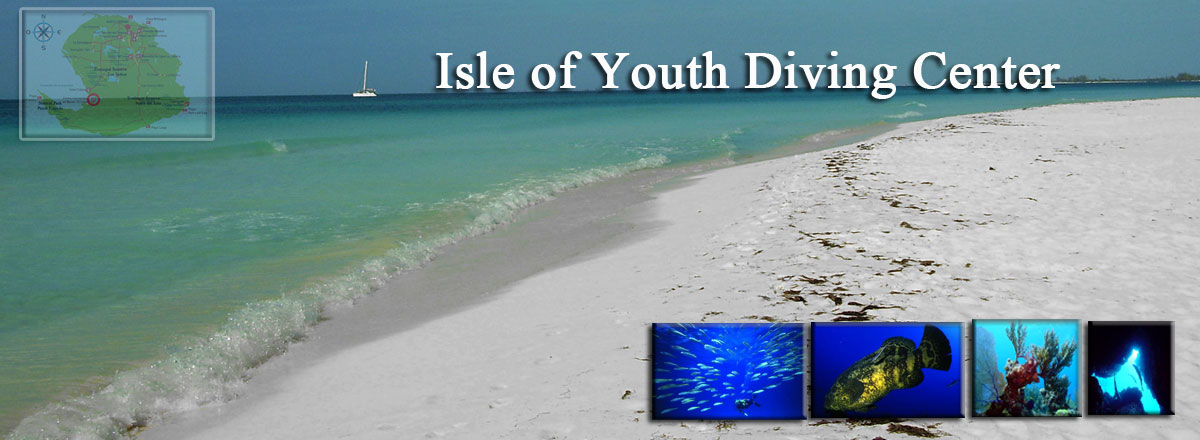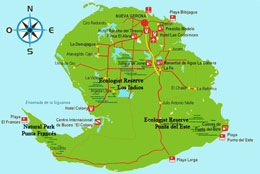The “Land of the Thousand Names”, which identifies the Isle of Youth due to the different names the island received over the time. San Juan Evangelista was the name given to this area by Christopher Columbus when he discovered the territory during his second trip to the region. Parrot Island or Treasure Island was among its first names during a time where the region was a refuge for pirates. For the indigenous population it was simply Siguanea, while the name of Isle of Pines was the longest used for the region’s vast number of pine forests.
Located south of Havana province, the Isle of Youth has an extension of 2200 square kilometers and occupies the largest area of the Los Canarreos archipelago south of Cuba challenging the waves of the Caribbean Sea that bathes its coasts. This territory is part of the 672 keys and islets that made up the archipelago, full of exuberant vegetation and rock formations. You can travel to the Isle of Youth by air from Havana or by ferry leaving from the Batabanó port in the southern part of Havana province.
The small city of Nueva Gerona is its capital and was founded in 1830 in honor of Girona, Spain. The city’s architecture has survived natural phenomena and the large columns are witness to the times of Spanish time. The important imprints of the time is the park, city hall which is now the municipal museum, its church, large monuments with the architecture of the early villas at the time. You must visit the El Abra Museum Farm where Cuba´s National Hero Jose Marti lived for a time and the Modelo Prison where President Fidel Castro and his companions were detained after the attack against the Moncada Garrison in Santiago de Cuba in 1953.
The Isle of Youth is surrounded by marble hills; it also has incredible rich nature, an ecosystem complex which includes its flora, fauna and landscapes. The Sierra de Caballo Mountains with 293 meters high and Las Casas 262 meters above sea level with a rock formation structure that guard the capital city of Nueva Gerona.
A vacationer can also witness Jones Jungle (forest farm with an ecological value) and the Crocodiles Farm in the Lanier Swamp, a rombifer (Cuban crocodile) reservoir only comparable with the Zapata Swamp located in Matanzas province. You might also be interested in the San Felipe Keys, the Los Indios ecological center and the Punta del Este Caves baptized as the Sistine Chapel due to its indigenous pictures.
Among some of the most interesting tourism spots are the Bibijagua Beach famous for its black sand due to an erosive action of the sea on the marble rocks. Nearby to Isle of Youth, also as part of Los Canarreos is Cayo Largo del Sur, one of most beautifull key of Cuba.
The Siguanea Bay is a great place for diving and there is a submarine photograph contest each year. For the underwater activities there are 56 immersion sights, several of them with important coral colonies, in addition to caves and tunnels. The experts highlight special points of the immersion with names like Pared de Coral Negro, Tunel del Amor, Cueva Azul, El Pasaje Escondido, Cueva de los Sabalos, Piedra de Coral, El Saldo, Ancla del Pirada, Paraiso de las Levisas y Pequeño Reino.
The main Diving Center is located at El Colony Hotel with a 6 kilometer coastline located between Punta Pedestales and Punta Frances. It has also a marina associated.
The legends of pirates, history and natural attractions make this small destiny of great interest for vacationers.
Protected Areas
Ecological Reserve Los Indios
Los Indios is located in the western center of the territory, between the hotel The Colony, La Victoria, Goldmine, Punta Buenavista and the Caribbean Sea to the west. It has an area of 5,395 ha with rivers Los Indios, Itabo and majagua. where is the reservoir Los Indios. Its ecological reserve is characterized by a system of savanna, with different types of evergreen forests grow pines and pot-bellied palms, forests very lush mangrove in very good condition on the coast of La Siguanea, rivers, estuaries, canals, bays, coastal lagoons and shallow seas that host a rich biodiversity.
Ecological Reserve Punta del Este
The area has an area of 97.36 square kilometer. It is considered a National Monument to contemplate a rich biodiversity, which highlights the wide variety of flora and lush vegetation, diversity of its land and marine fauna, and from the standpoint of equity, has a cave system constitutes important testimony of prehistory, in perfect harmony with their environment. The place is reserved as a heritage legacy. It is located 60 kilometers to Nueva Gerona and only by terrestrial.
Natural Park Punta Francés
It is located on the southwest coast of the Isle of Youth to 118 km from the city of Nueva Gerona . It extends from Punta Pedernales to Cabo Frances, at the western end of the Peninsula Carapachibey. Aquí is one of the best preserved coastal ecosystems. The selection of the place has its origin in an unspoilt nature and rich.
Canarreos Reefs.
The Canarreos-coral archipelago, with 672 islands and islets, is the second-biggest coral reef of the world and extends from Cuba up to the Bahamas. The treasure Island possesses a total surface of 2.199 square kilometres and is consequently eight times bigger than the Island Malta. This beautiful Island with its fantastic underwater precincts of the Canarreos Reefs cares the world about the second longest coral formation.




